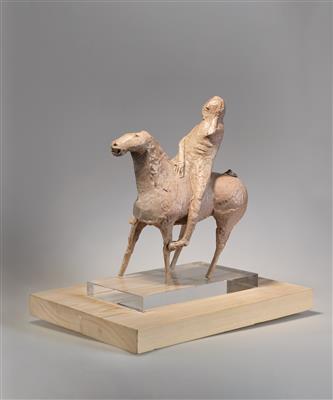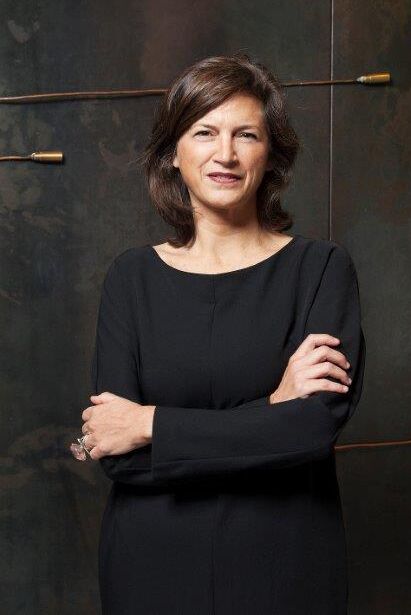Marino Marini *

(Pistoia 1901–1980 Viareggio)
Piccolo cavaliere, 1949, one variant, ceramic, painted and glazed,
height 39.4 cm
Executed in an edition of four + one variant. This work is unique.
This work is accompanied by a certificate of authenticity signed by the artist.
Provenance:
Lorenzo Papi Collection, Florence
Attilio Bacci Collection, Milan
European Private Collection
Literature:
G. di San Lazzaro, P. Waldberg & H. Read, Marino Marini, Complete Works, New York, 1970, no. 251, ill.
C. Pirovano, Marino Marini Scultore, Milan, 1972, no. 257, ill.
M. Meneguzzo, Marino Marini Cavalli e Cavalieri, Milan, 1997, no. 46, ill.
Fondazione Marino Marini (ed.), Marino Marini: Catalogue raisonné of the Sculptures, Milan, 1998, no. 325 (another version ill.)
“Equestrian statues have always served, through the centuries,
a kind of epic purpose. They set out to exalt a triumphant hero,
a conqueror like Marcus Aurelius… In the past fifty years,
this ancient relation between man and beast has been entirely transformed. The horse has been replaced, in its economic
and its military functions, by the machine, by the tractor,
the automobile or the tank.”
Marino Marini
Marino Marini owed his international fame in the 1950s to his “cavalieri”, or equestrian figures – an anything but modern subject combined with the overwhelming weight of an ancient iconographic tradition. But Marini offers no monuments of triumph, no symbols of power. His riders
are tragic figures. They are representatives of the drama of humanity, and show a striking reference to the gloomy existential conditions of the post-war period.
Marini’s early equestrian figures still convey an impression of relative balance: the rider controls the animal and is clearly distinct from it (as in the present work). Later on, the rider merges increasingly with the animal, becoming more and more powerless. Finally, the horse collapses to the ground, as in Saul’s conversion, and the rider is thrown from it. Hard edges and uneven surfaces reinforce the over-all impression of disharmony.
Munich, Residenz, March – April 1984, Marino Marini, Plastiken, Bilder, Zeichnungen, exh. cat.
Specialist: Mag. Patricia Pálffy
 Mag. Patricia Pálffy
Mag. Patricia Pálffy
+43-1-515 60-386
patricia.palffy@dorotheum.at
04.06.2019 - 17:00
- Estimate:
-
EUR 80,000.- to EUR 120,000.-
Marino Marini *
(Pistoia 1901–1980 Viareggio)
Piccolo cavaliere, 1949, one variant, ceramic, painted and glazed,
height 39.4 cm
Executed in an edition of four + one variant. This work is unique.
This work is accompanied by a certificate of authenticity signed by the artist.
Provenance:
Lorenzo Papi Collection, Florence
Attilio Bacci Collection, Milan
European Private Collection
Literature:
G. di San Lazzaro, P. Waldberg & H. Read, Marino Marini, Complete Works, New York, 1970, no. 251, ill.
C. Pirovano, Marino Marini Scultore, Milan, 1972, no. 257, ill.
M. Meneguzzo, Marino Marini Cavalli e Cavalieri, Milan, 1997, no. 46, ill.
Fondazione Marino Marini (ed.), Marino Marini: Catalogue raisonné of the Sculptures, Milan, 1998, no. 325 (another version ill.)
“Equestrian statues have always served, through the centuries,
a kind of epic purpose. They set out to exalt a triumphant hero,
a conqueror like Marcus Aurelius… In the past fifty years,
this ancient relation between man and beast has been entirely transformed. The horse has been replaced, in its economic
and its military functions, by the machine, by the tractor,
the automobile or the tank.”
Marino Marini
Marino Marini owed his international fame in the 1950s to his “cavalieri”, or equestrian figures – an anything but modern subject combined with the overwhelming weight of an ancient iconographic tradition. But Marini offers no monuments of triumph, no symbols of power. His riders
are tragic figures. They are representatives of the drama of humanity, and show a striking reference to the gloomy existential conditions of the post-war period.
Marini’s early equestrian figures still convey an impression of relative balance: the rider controls the animal and is clearly distinct from it (as in the present work). Later on, the rider merges increasingly with the animal, becoming more and more powerless. Finally, the horse collapses to the ground, as in Saul’s conversion, and the rider is thrown from it. Hard edges and uneven surfaces reinforce the over-all impression of disharmony.
Munich, Residenz, March – April 1984, Marino Marini, Plastiken, Bilder, Zeichnungen, exh. cat.
Specialist: Mag. Patricia Pálffy
 Mag. Patricia Pálffy
Mag. Patricia Pálffy
+43-1-515 60-386
patricia.palffy@dorotheum.at
|
Buyers hotline
Mon.-Fri.: 10.00am - 5.00pm
kundendienst@dorotheum.at +43 1 515 60 200 |
| Auction: | Modern Art |
| Auction type: | Saleroom auction |
| Date: | 04.06.2019 - 17:00 |
| Location: | Vienna | Palais Dorotheum |
| Exhibition: | 25.05. - 04.06.2019 |

